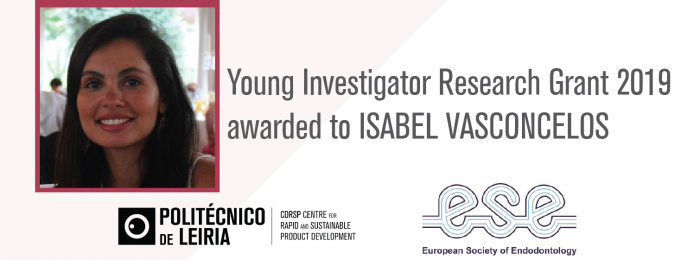European Society of Endodontology (ESE) Young Investigator Research Grant 2019 awarded to ISABEL VASCONCELOS
The European Society of Endodontology (ESE) awards young researcher grants to support young investigators in the early phase of their research career in Endodontology (“young” investigator in the context of this award is defined as an individual who is ‘professionally’ young in academic terms rather than in chronological age, e.g. pre-doctoral students at all levels (MSc, PhD students and equivalent), and up to 3 years following the award of a PhD (or equivalent).
Summary of project
“CAN WE USE A BIOCERAMIC ROOT CANAL SEALER IN A WARM OBTURATION TECHNIQUE?”
This Project results from collaboration between three Portuguese Universities: School of Dental Medicine (University of Lisbon), Center for Rapid and Sustainable Product Development (Polytechnic Institute of Leiria) and Department of Mechanical Engineering (University of Aveiro).
The aim of the first part of this Project will be to characterize the physicochemical properties of three sealers (Endosequence BC Sealer, HiFlow BC Sealer and AH Plus) and also to measure the physical changes when warmed.
The physicochemical properties studied will be: setting time, Fourrier transferred infrared spectroscopy (FT-IR), differencial scanning calorimetry (DSC), thermo gravimetry analysis (TGA) and calcium release analysis. Also, in the three sealers, scanning electron microscopy (SEM) will be used to evaluate the arrangement of particles, particle size and chemical elements present with
energy dispersive x-ray spectroscopy (EDX).
The second part will be focus on testing the functionality of the sealers by evaluating the quality of canal filling with micro-computed tomography (porosity). The epoxy resin-based sealer, AH Plus, will be compared with a newer bioceramic sealers, EndoSequence BC Sealer and HiFlow BC Sealer (Brasseler USA, Savannah, GA, USA), using two techniques: a cold technique
(single cone) and a thermoplastic technique (continuous wave).
The third part of this Project it will use a surrogate endpoint to measure the sealing ability. To understand the dimensional stability of the fillings related to different filling materials and different filling techniques that will be used in this project, the micro-CT technique will evaluate the 3Dimensional volumetric changes of the materials. The volume of porosity will be calculated immediately post-obturation and then six months later after the specimens have been stored in an artificial medium.
Ultimately, the project, will test if the advantages of bioceramic technology can provide the ability to produce root fillings with quality and stability in a longterm way, testing if a bioceramic-based sealer could be used in a cold technique, with an easy handling and straightforward technique like single-cone, or could be applied in a warm obturation technique, sustained in the physicochemical characterization and in the suitability of the sealers to be used when warm.




